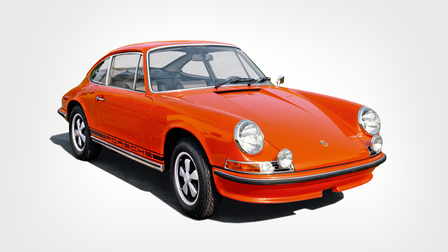
Conceiving Color
Communication color:
This hue is used in all communications pertaining to a specific car model. Sina Brunner checks the color under the light.
This
If you pose the question on the left to Barbara Sika and Daniela Milošević, their first response will be a knowing smile. The two designers develop paint colors for new
Whether future GT3 RS owners will flock to this unusual hue has yet to be seen. In fact, the designers are well aware that the color has the potential to polarize. And that’s OK. What’s more, it’s even encouraged. That’s because Lizard Green is not simply a color but what’s known as a communication color. “By that we mean the precise hue that’ll be used for a specific model in all of its marketing,” explains Sina Brunner, who coordinates design with sales. “This particular hue will feature in all product communications, starting with the world premiere and the initial advertising campaigns.” And pleasing people is by no means the most important job of a communication color. Instead, its main purpose is to accentuate the unusual and unique qualities of a
In order for this process to be successful, the color designers need to have their finger on the pulse of current trends—and possess extraordinary visionary skills. That’s because it takes years to develop a new color of paint—which also means a new communication color. One reason for this has to do with the extremely high demands that
Teamwork:
Daniela Milošević and Barbara Sika (photo above, from left) examine a paint swatch for the new 911 GT3 RS.
Putting paints through their paces
Developers use these tests, which take place at specially equipped trial fields in desert regions, to ensure that a new paint color won’t change in any way over time. In addition to weathering tests, new paints are subjected to other rigorous trials that assess their resistance to substances like saltwater or rim cleaners. It’s also critical that the paint on high-performance sports cars like the 911 GT3 RS be highly resistant to impact from stones or other debris, because it tends to be subjected to these conditions more often than other cars.
All of these development steps and test cycles take time. The designers generally adopt a three-step approach. They first look back at the car’s history. “If you’re not familiar with the past, you can’t shape the future,” says Sika. The color experts therefore first analyze all the previous communication colors used for a particular car, from its very first version to its most recent incarnation. “If we want to give each derivative its own unique color, the new shade can’t be too close to that of the previous model,” explains Milošević.
Next, color designers come up with initial ideas and discuss them with their sales colleague Sina Brunner. Which colors reflect the car’s character well, and which ones less so? The final step requires the designers to anticipate which colors will be popular when the new model actually comes onto the market some years later. “One important source of inspiration for us is the furniture industry, which also needs a long lead time for its colors,” says Milošević. Of additional interest are the individual colors that
![[+]](https://staging.www.porsche.com/filestore/image/multimedia/none/christophorus-issue386-article03-content-01/normal/ef2cbc85-374b-11e8-bbc5-0019999cd470/porsche-normal.jpg)
Lizard Green:
An extroverted color that expresses sportiness, agility, and nimbleness.
Paints with a colorful tradition
Signal Yellow from the 1970s,“a classic, uniquely
Signal Yellow
911 S 2.7
Viper Green
911 T 2.4
Tangerine
911 S 2.4
Star Ruby
911
The team distills these different steps down to a proposal that identifies a potential shade with several nuances and effects, such as metallic paints or pearlescent pigments. The samples are applied to small pieces of sheet steel and discussed by a larger circle of experts, including specialists from production, technical development, design, sales, and marketing. “We use this larger forum to determine which color ideas are technically feasible in general,” Brunner explains. It’s also important to consider, from the designers’ perspective, all the materials that will be used elsewhere in the car. Because regardless of how well a color might be suited as an exterior paint, it ultimately has to harmonize with the leather, Alcantara, and other materials on the interior. Only after all of these questions have been answered can technical development work on the communication color begin.
How and why a particular color becomes fashionable can never be definitively explained. But one thing is clear: certain cycles keep recurring. The fashion industry usually sets the tone. Interior decorators then pick up on certain trends, followed by the furniture industry. “If you trace the history of certain colors over a period of decades you can see that trends reappear with surprising regularity,” notes Sika. A good example would be white, which was a very popular color for cars in the 1970s, but then became nearly taboo in the 2000s before enjoying a comeback in the 2010s. Today, it’s particularly in vogue for electric cars—and when used as a communication color is meant to convey values like purity and environmental friendliness.
Given a name like Signal Yellow or Star Ruby, the color then enters a lifelong association with the car model for which it was developed. Its role is primarily restricted to marketing and communications, but not always. The predecessor model to the
By Laurin Paschek
Photos by Rafael Krötz,
![[+]](https://staging.www.porsche.com/filestore/image/multimedia/none/christophorus-issue386-article03-margin-01/normal/cf648611-374b-11e8-bbc5-0019999cd470/porsche-normal.jpg)
![[+]](https://staging.www.porsche.com/filestore/image/multimedia/none/christophorus-issue386-article03-margin-02/normal/d79f2ddb-374b-11e8-bbc5-0019999cd470/porsche-normal.jpg)
![[+]](https://staging.www.porsche.com/filestore/image/multimedia/none/christophorus-issue386-article03-margin-03/normal/d79f2ddc-374b-11e8-bbc5-0019999cd470/porsche-normal.jpg)











